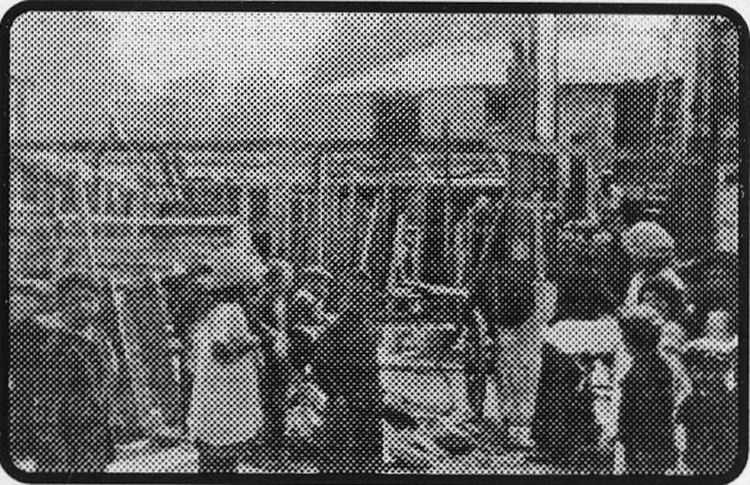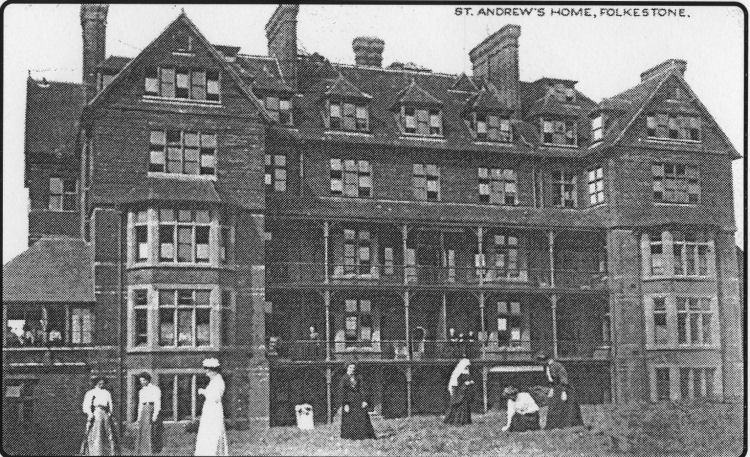
Published 18 September 2003


TONTINE Street, the scene of tragedy in an air raid in 1917. Here
rebuilding work is under way.
This raid, which cost the lives of 77 people, is to feature in a new book by
local author Martin Easdown. See details below.
Smugglers
JIM Bridges, MBE, who lives at The Durlocks, was very interested in Paul
Emden’s notes and photographs regarding the area around St Andrew’s, the
former convalescent home, at East Cliff Gardens.
Jim says that the name The Durlocks really applies only to the small estate
of 33 houses and flats to the west of St Andrew’s, which was built in the
early 1920s on land previously known as “Ellen’s Field.”
“The estate was named from the open area on its southern side called The
Durlocks and known locally as “The Bank.” “The Durlocks Bank played a
significant role in the history of the local fishing community. In the
heyday of smuggling, when the men were about to run contraband ashore in
East Wear Bay, their womenfolk would light signal fires to warn them if
Revenue Officers were in the area.
“In 1820 a number of local smugglers were arrested and imprisoned in Dover
Gaol. Their wives and other local people gathered on The Durlocks Bank and
marched to Dover where they were met by some of the towns people.
“The combined mobs then literally demolished the gaol and released the
Folkestone men!
“Later in the 19th Century Lord Radnor gave The Durlocks Bank to the fisher
folk to use as a net-drying area.”
Jim goes on to say that St Andrew’s continued to be used as a convalescent
home
until the outbreak of World War Two, in 1939, when it closed. It had been
hoped to re-open it again after the war when it was requisitioned by the
government, but this was not to be.”
In 1947, however, it opened as a Workers’ Travel Association guest house,
later becoming the World Travel Association. In the late 1940s the chapel
was formerly deconsecrated by the then Archbishop of Canterbury.
During the early 1970s, adds Jim, St Andrew’s became The Galleon Hotel and,
in 1978, it was bought by Mrs Carpenter, a local businesswoman and became
The Continental Hotel. But, in the mid 1980s, it closed and was re-developed
as flats.
This development was not a success for various reasons, and it was bought
and renovated by another developer.
“Fine conversion”
“Today St Andrew’s stands as a fine example of the conversion of a splendid
Victorian building to the needs of modern living.”
Peter Croucher, of Southwater, West Sussex, who was born at No. 24 The
Durlocks, in 1928, also contacted me about Memories references to The
Durlocks, to say he would like an old photograph.
I sent him a copy of a photo of the First World War tank which used to be a
striking landmark just below the school until the Second World War when it
was “reclaimed” by the Government for re-cycling, and he
was delighted. The Town Council decided the tank should be scrapped for
re-cycling in 1937, along with a field gun kept at the council depot and a
mine and German gun on show on the seafront at Battery Point.
“It reminds me of the time I used to play on - and in the tank,” writes
Peter, who says he is making a return visit to the area next month.
On the warm spring evening of May 25, 1917, the tranquility of Folkestone
was shattered by an air raid. German Gotha bombers, flying on their first
ever attack on the UK, killed 77 people in the district, 61 of them in
Tontine Street.
And now, I hear, the story is to feature in a lavishly illustrated new book.
The local writer is Martin Easdown, already well known for several works on
local history.
The new paperback, to be called A Glint in the Sky, will feature German air
attacks on Folkestone, Dover and other Kent resorts during the First World
War, with eye-witness accounts of the raids, a record and biographical
details of the Folkestone victims, together with recollections of some
German airmen involved.
The book is set to be published next year by Pen & Sword Books Ltd, of
Barnsley, who say Martin’s painstaking research into the Folkestone raid and
other attacks highlights extraordinary events that have been neglected in
histories of Folkestone and the surrounding area.
 |
Widespread damage as storm rages in Channel
«f QftOTHE Switchback was badly damaged, •l>«7\/OSandgate tramway
service was brought to a halt, boats were washed away from the beach and
others damaged, and the Alfred Bevan convalescent home in Sandgate was
seriously damaged in a "furious gale" which hit the coast a century ago,
the wind in places reaching hurricane force. Passengers on the
cross-Channel steamers had a worrying time as vessels battled through
heavy seas and there were fears for the excursion steamer "Alexandra"
which left Folkestone for Hastings before the storm broke. Hythe Canal
was festooned with fallen trees, there was serious erosion at Battery
Point, Sandgate beach groynes were swept away and waves hit the rear of
the Alhambra Music Hall at Sandgate, smashing windows and causing damage
to the stage and scenery. At Dover a police inspector was killed as men
tried to launch the lifeboat. Former local resident Dr W.V. Eaves, who
learned to play at Folkestone's Pleasure Gardens, triumphed in
Folkestone Lawn Tennis Tournament in the gardens, winning the Cinque
Ports' All Comers' Open Championship Challenge Cup and other prizes.
|
Novel new attraction for visitors at Dungeness
«f q/jq FAMOUS Dungeness "backstays," X«/&Ono, not grandmothers' corsets
(!) made their debut, 75 years ago. Hundreds of visitors, many of whom
reached Dungeness via the world's smallest railway, the Romney, Hythe
and Dymchurch Railway, learned to walk on the loose shingle with ease,
aided by a novel form of footwear called "backstays." With these curious
pieces of wood strapped to normal shoes you could, with practice, walk
or slide across the shingle. As holidaymakers wrestled with this new
wonder, enterprising fishermen were touting for business, putting up
notices advertising teas at their curious tar-coated boatmen's huts,
some of them converted railway carriages. The Folkestone Brotherhood of
Cheerful Sparrows defied pessimists and its annual hospital fete again
proved successful, in spite of a new law outlawing the traditional
tombola competition, a big money spinner. In its place was a
"Compensation Competition" which was well supported by gifts of prizes
following an appeal. A new "thrill was offered by an aircraft in which
L.J. Skytrips Ltd was giving joy flights from Folkestone. This was the
spectacle of a pilot trying to 'bomb' a high-speed motorboat, the Tarpin,
with bags of flour, off the beach.
|
Action demanded on bus shelters needed by town
>f OVER a thousand people filled the
Leas Cliff Hall to hear a concert by the accomplished British Concert
Orchestra conducted by national celebrity Vic Oliver - the talented
musician and comedian, who gave two concerts a year at Folkestone for at
least six years, one as a comedian and one as a musician. Passenger
traffic at Lympne airport reached a new high in July 1953 of four short
of 20,000, and a new record was expected in August. Folkestone received
a £1,000 grant from the Lord Mayor's Air Raid Distress Fund. The
organisers of the fund suggested the money might best be spent on
non-residential old people's clubs, youth clubs or children's
playgrounds. After a particularly wet summer downpour a retired army
major was complaining in the letters columns of the Herald that
Folkestone bus station had no proper shelters, saying it was bad
publicity for the town. A sympathetic editorial comment told how plans
for a proper Bouverie Square bus station had been passing backwards and
forwards between the bus company and various authorities for four years!
|
Put hooligans in the stocks - suggests district’s MP!
«f Q-yQ SHEPWAY Council's plans sub-com-.L«7 / Omittee approved plans
for a minihousing estate north of Aerodrome Road, at Hawkinge, to
consist of 47 homes and 16 garages, built around a T-shaped estate road,
with a communal courtyard or open space. At Hythe it was agreed by the
Shepway council to continue to operate the Cinque Ports Pavilion for
another year but to look around for a commercial operator to run it
thereafter. Production of a pocket language translator by a Folkestone
company was expected to create 20 new jobs in the district. Tibavale
Ltd, of Cheriton High Street, was marketing the cassette-sized aid said
to be cheaper than a correspondence course or set of phrase books. It
was aimed at travellers and holidaymakers all over the world. Local MP
Albert Costain had a simple idea to curb violence, particularly in
public houses - a spell in good old fashioned stocks for the hooligans.
Heavy rain and flattened crops was a local problem 25 years ago and one
Elham farmer warned that another bad week would be disastrous. Police
were criticised about lack of protection for valuable craft moored in
the harbour, after the "Compass Rose" was ransacked. |
|



